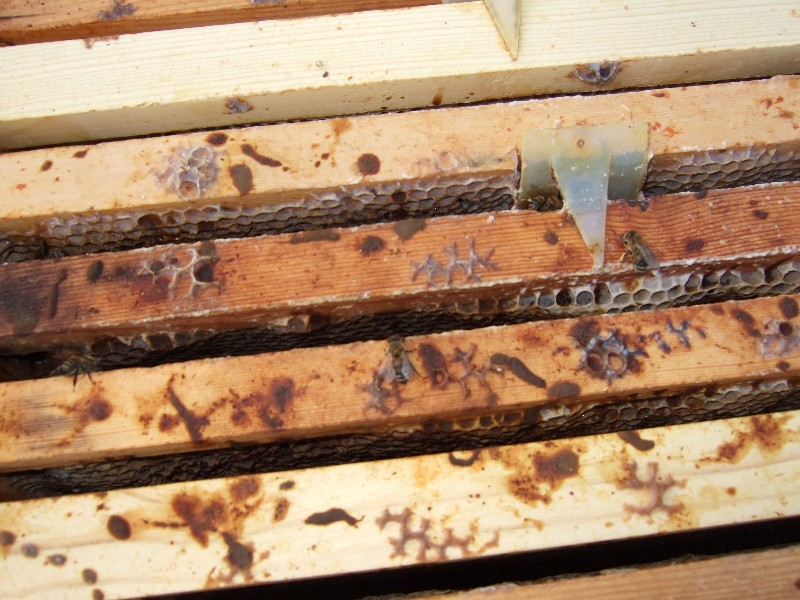Honeybee Diseases - Nosema
Nosema - is a disease of adult bees caused by a spore-forming protozoan (Nosema apis) that invades the digestive tracts of honey bee workers, queens, and drones. The spores of the Nosema apis, usually ingested with food or water by the adult bee, germinate and multiply within the lining of the mid-gut. Millions of spores are shed into the digestive tract and are passed in the faeces. Damage to the bees digestive tract produces dysentery and weakens the bees, shortening the productive life of the worker, and reducing its ability to produce brood food. This in turn affects brood production and colony development particularly in early season. Infected queens' egg production and life span are reduced, leading to supersedure. Infected workers, unlike healthy workers, may defecate in the hive. Diseased colonies usually have increased winter losses and decreased honey production.
Nosema infections are frequently present in most apiaries at low levels without causing significant damage. It is aggravated by stress, colony disturbance in winter as well as during summer increases the risk of detectable disease level.
Download the Nosema Info Sheet to obtain a printable version of Nosema information, detection and treatment methods for your records.
Recognition
Image Courtesy The Animal and Plant Health Agency (APHA), © Crown Copyright

Dysentery on the top bars of frames caused by Nosema apis
The presence of nosema disease is not usually recognised until most of the bees in the colony are infected since it does not produce signs or symptoms that are easily recognized under field conditions. Defecation in the hive and signs of unusual faeces on hive parts can be tell tale signs. The only positive way of identifying the disease is through dissection of adult bees. Suspect colonies should have samples taken and sent off to SASA in a paper bag for analysis.
Detection
Hive Examination - Examination of hives, components and debris is required especially in spring. Abnormalities such as the signs of dysentery, crawling and dead bees are easily spotted.
Monitoring - Vigilance is important with all honeybee diseases. Check all apiaries and colonies regularly for health and suspect any colonies that are not thriving where there is no already known reason. Colonies that die out should be examined thoroughly and sealed to prevent robbing and spread of any disease present.
Treatment
Transferring the infected colony on to clean comb and disinfecting comb and hives parts is recommended. Prevention is the best method of controlling this condition by maintaining healthy, strong and vigorous colonies that display good hygienic traits. Always ensure there is enough available food for the colony during periods of bad weather. Good husbandry contributes greatly to overall colony behaviour and health, thereby avoiding the conditions in which Nosema can occur. Fumidil 'B' can be used in spring and autumn to inhibit spore reproduction in the bee gut however it does not kill the spores. Sterilisation of contaminated equipment can be carried out by the Acetic acid sterilization process. Dead brood will be removed by bees from the cells as soon as the colony grows stronger and returns to normal. Disease prevention is best practice, maintain good apiary housekeeping:
- Always maintain strong and vigorous colonies that show good hygienic tendencies, re-queen from known healthy disease resistant colonies.
- Always maintain a high level of hygiene in all your beekeeping practices
- Carry out methodical health inspections on a regular basis, checking for brood disease particularly in spring and autumn.
- Never transfer combs between colonies without checking for brood diseases
- Systematically replace old brood combs in your hives melting down the old comb to maintain clean and healthy brood.
- Never bring colonies or equipment into your apiary without establishing their origin, condition, and disease status.
- Sterilise any secondhand equipment or hive components before introducing them into your apiary
- Discourage drifting and robbing in the apiary
- Suspect stray swarm health until you know otherwise
- Report any incidence of disease or suspicious conditions immediately to your local beekeeping association / community.
Vectors
Nosema spores can exist in beekeeping equipment, honey, wax, etc. and can spread during normal hive / colony manipulations.
- Beekeepers - Transferring contaminated equipment / material between hives, colonies and apiary sites.
- Crushed Bees - Bees will clean up any crushed bees during normal house keeping activities and can pick up and spread disease quickly through the colony.
- Robbing - Colonies weakened by other ailments will fall prey to robbing, transferring disease to other colonies and apiaries.
- Drifting - As with Robbing will transfer disease to other colonies.
- Swarming - Swarms can carry the spores with them to new sites where the disease can spread.
Try the Honeybee Diseases Quiz
About the 'My Beekeeping Kit' website.
Contact Iain Dewar for enquiries, suggestions, corrections and contributions for improving the notes. Always welcome!